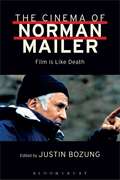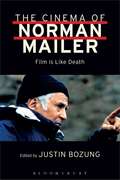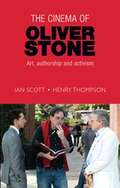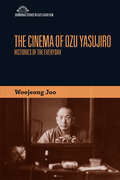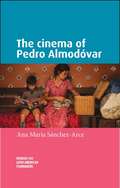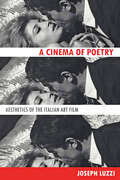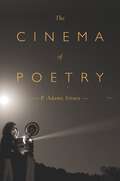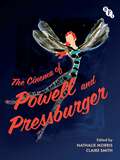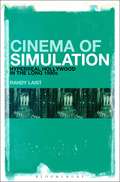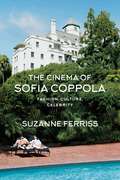- Table View
- List View
Cinema of Interruptions: Action Genres in Contemporary Indian Cinema
by Lalitha GopalanA framework for understanding the distinctiveness of Indian cinema as a national cinema within a global context dominated by Hollywood is proposed by this book. With its sudden explosions into song-and-dance sequences, half-time intermissions and heavy traces of censorship, Indian cinema can be identified as a 'Cinema of Interruptions'. To the uninitiated viewer, brought up on the seamless linear plotting of Hollywood narrative, this unfamiliar tendency towards digression may appear random and superfluous, yet this book argues that such devices assist in the construction of a distinct visual and narrative time-space. In the hands of imaginative directors, the conventions of Indian cinema become opportunities for narrative play and personal expression in such films as 'Sholay' (1975), 'Nayakan' (1987), 'Parinda' (1989), 'Hathyar' (1981) and 'Hey Ram!' (1999). 'Cinema of Interruptions' places commercial Indian film within a global system of popular cinemas, but also points out its engagement with the dominant genre principles implemented by Western film. By focusing on the action-genre work of leading contemporary directors J.P. Dutta, Mani Ratnam, and Vidhu Vinod Chopra, brazen national style is shown to interact with international genre films to produce a hybrid form that reworks the gangster film, the western and the avenging woman genre. Central to this study is the relationship Indian cinema shares with its audience, and an understanding of the pleasures it offers the cinephile. In articulating this bond the book presents not only a fresh framework for understanding popular Indian cinema but also a contribution to film genre studies.
The Cinema of Jia Zhangke: Realism and Memory in Chinese Film (World Cinema)
by Cecília MelloDespite his films being subjected to censorship and denigration in his native China, Jia Zhangke has become the country's leading independent film director internationally. Seen as one of world cinema's foremost auteurs, he has been playing a crucial role in documenting and reflecting upon his country's era of intense transformations since the 1990s.This book offers innovative scholarship and in-depth analysis of Jia's unique body of work from his opening act Platform, to experimental quasi-documentary 24 City through to the audacious addition of Mountains May Depart. Drawing on classic and contemporary realism theory, it suggests that his particular expression of the realist mode is greatly shaped by the aesthetics of other Chinese artistic traditions. These traditions allow Jia to unearth memories both personal and collective, still lingering within the ever-changing landscapes of contemporary China. Interweaving issues relating to cinema, painting, architecture, opera, pop music, literature, geography and history, chapters address the very nature of the so-called 'impure' cinematographic art and in addition the complex representation of China through the ages. Proving of value to students and scholars of film studies and to admirers of Jia's work, this book opens the door into Chinese cinema and culture at a time when the country is at the centre of the world's attention.
The Cinema of Jia Zhangke: Realism and Memory in Chinese Film (World Cinema)
by Cecília MelloDespite his films being subjected to censorship and denigration in his native China, Jia Zhangke has become the country's leading independent film director internationally. Seen as one of world cinema's foremost auteurs, he has played a crucial role in documenting and reflecting upon China's era of intense transformationssince the 1990s.Cecília Mello provides in-depth analysis of Jia's unique body of work, from his early films Xiao Wu and Platform, to experimental quasi-documentary 24 City and the audacious Mountains May Depart. Mello suggests that Jia's particular expression of the realist mode is shaped by the aesthetics of other Chinese artistic traditions, allowing Jia to unearth memories both personal and collective, still lingering within the ever-changing landscapes of contemporary China. Mello's groundbreaking study opensa door into Chinese cinema and culture, addressing the nature of the so-called 'impure' cinematographic art and the complex representation of China through the ages.Foreword by Walter Salles
A Cinema of Loneliness
by Robert KolkerAn updated and expanded version of this classic study of contemporary American film, the new edition of A Cinema of Loneliness reassesses the landscape of American cinema over the past decade, incorporating discussions of directors like Judd Apatow and David Fincher while offering assessments of the recent, and in some cases final, work from the filmmakers--Penn, Scorsese, Stone, Altman, Kubrick--at the book's core.
A Cinema of Loneliness
by Robert KolkerAn updated and expanded version of this classic study of contemporary American film, the new edition of A Cinema of Loneliness reassesses the landscape of American cinema over the past decade, incorporating discussions of directors like Judd Apatow and David Fincher while offering assessments of the recent, and in some cases final, work from the filmmakers--Penn, Scorsese, Stone, Altman, Kubrick--at the book's core.
The Cinema of Manoel de Oliveira: Modernity, Intermediality and the Uncanny
by Hajnal KirályManoel de Oliveira is the only filmmaker whose career spans from the silent era to the digital age, and yet there is little written in English about his extensive filmography. This volume, the first to discuss Oliveira's later works in English, fills this incredible gap in scholarship on the director with fresh and original analysis of over 50 of Oliveira's films, ranging from 1963's Rite of Spring to 2009's Eccentricities of a Blonde-haired Girl.Organized by tropes and topics, rather than chronological order of release, The Cinema of Manoel de Oliveira creates a unique lens through which to consider the director and the ways in which his work links cinema, literature, and other artforms. Hajnal Király sheds new light on Oliveira's filmography with new readings of his work in relation to 20th and 21st century history.
The Cinema of Manoel de Oliveira: Modernity, Intermediality and the Uncanny
by Hajnal KirályManoel de Oliveira is the only filmmaker whose career spans from the silent era to the digital age, and yet there is little written in English about his extensive filmography. This volume, the first to discuss Oliveira's later works in English, fills this incredible gap in scholarship on the director with fresh and original analysis of over 50 of Oliveira's films, ranging from 1963's Rite of Spring to 2009's Eccentricities of a Blonde-haired Girl.Organized by tropes and topics, rather than chronological order of release, The Cinema of Manoel de Oliveira creates a unique lens through which to consider the director and the ways in which his work links cinema, literature, and other artforms. Hajnal Király sheds new light on Oliveira's filmography with new readings of his work in relation to 20th and 21st century history.
The Cinema of Norman Mailer: Film is Like Death
by Norman Mailer Justin BozungThe Cinema of Norman Mailer: Film is Like Death not only examines the enfant terrible writer's thoughts on cinema, but also features interviews with Norman Mailer himself. The Cinema of Norman Mailer also explores Mailer's cinema through previously published and newly commissioned essays written by an array of film and literary scholars, enthusiasts, and those with a personal, philosophical connection to Mailer. This volume discusses the National Book Award and Pulitzer Prize-winning author and filmmaker's six films created during the years of 1947 and 1987, and contends to show how Mailer's films can be best read as cinematic delineations that visually represent many of the writer's metaphysical and ontological concerns and ideas that appear in his texts from the 1950s until his passing in 2007. By re-examining Mailer's cinema through these new perspectives, one may be awarded not just a deeper understanding of Mailer's desire to make films, but also find a new, alternative vision of Mailer himself. Norman Mailer was not just a writer, but more: he was one of the most influential Postmodern artists of the twentieth century with deep roots in the cinema. He allowed the cinema to not only influence his aesthetic approach, but sanctioned it as his easiest-crafted analogy for exploring sociological imagination in his writing. Mailer once suggested, "Film is legitimately more interesting than books..." and with that in mind, readers of Norman Mailer might begin to rethink his oeuvre through the viewfinder of the film medium, as he was equally as passionate about working within cinema as he was about literature itself.
The Cinema of Norman Mailer: Film is Like Death
by Norman Mailer Justin BozungThe Cinema of Norman Mailer: Film is Like Death not only examines the enfant terrible writer's thoughts on cinema, but also features interviews with Norman Mailer himself. The Cinema of Norman Mailer also explores Mailer's cinema through previously published and newly commissioned essays written by an array of film and literary scholars, enthusiasts, and those with a personal, philosophical connection to Mailer. This volume discusses the National Book Award and Pulitzer Prize-winning author and filmmaker's six films created during the years of 1947 and 1987, and contends to show how Mailer's films can be best read as cinematic delineations that visually represent many of the writer's metaphysical and ontological concerns and ideas that appear in his texts from the 1950s until his passing in 2007. By re-examining Mailer's cinema through these new perspectives, one may be awarded not just a deeper understanding of Mailer's desire to make films, but also find a new, alternative vision of Mailer himself. Norman Mailer was not just a writer, but more: he was one of the most influential Postmodern artists of the twentieth century with deep roots in the cinema. He allowed the cinema to not only influence his aesthetic approach, but sanctioned it as his easiest-crafted analogy for exploring sociological imagination in his writing. Mailer once suggested, "Film is legitimately more interesting than books..." and with that in mind, readers of Norman Mailer might begin to rethink his oeuvre through the viewfinder of the film medium, as he was equally as passionate about working within cinema as he was about literature itself.
The Cinema of Nuri Bilge Ceylan: The Global Vision of a Turkish Filmmaker
by Graeme Gilloch Bülent Diken Craig HammondFilm maker Nuri Bilge Ceylan's meditative, visually stunning contributions to the 'New Turkish Cinema' have marked him out as a pioneer of his medium. Reaping success from his prize-winning, breakout film Uzak (2002), and from later festival favourites Once Upon a Time in Anatolia (2011) and Winter Sleep (2014), he has quickly established himself as an original and provocative writer, director and producer of 21st century cinema. In an age where Turkey's modernisation has created societal tensions and departures from past tradition, Ceylan's films present a cinema of dislocation and a vision of 'nostalgia' understood as homesickness: sick of being away from home; sick of being at home. This book offers an overdue study of Ceylan's work and a critical examination of the principle themes therein. In particular, chapters focus on time and space, melancholy and loneliness, absence, rural and urban experience, and notions of paradox, as explored through films which are often slow and uncompromising in their pessimistic outlook. Moving on from the tendency to situate Ceylan's oeuvre exclusively within the canon of 'New Turkish Cinema', one of this book's major achievements is also to assess the influence of classic European thought, literature and film and how such a notably minimal – and in many ways nationally-specific – approach translates to an increasingly transnational context for film. This will prove an important book for film students and scholars, and those interested in Turkish visual culture.
The cinema of Oliver Stone: Art, authorship and activism (PDF)
by Henry Thompson Ian ScottThis book analyses the work of Oliver Stone - arguably one of the foremost political filmmakers in Hollywood during the last thirty years. From early productions like Platoon (1986) and Wall Street (1987) to contemporary dramas and documentaries such as World Trade Center (2006), Wall Street: Money Never Sleeps (2010) and The Untold History of the United States (2012) Stone has re-defined political filmmaking in an era when Hollywood and the United States in general has been experiencing rapid and radical change. Drawing on previously unseen production files as well as hours of interviews with the director and his associates within the industry, this book is a thematic exploration of Stone's life and work, charting the development of political and aesthetic changes in his filmmaking. Those changes are mapped onto academic debates about the relationship between film and history as well as wider critiques about Hollywood and the film industry. 'A wonderful, bracing book, Scott and Thompson have brought exemplary clarity and thoroughness to the complex and multifaceted career of Oliver Stone. Dividing Stone's work into major themes such as War, Money and Love, the authors provide a focused exploration of the critical intelligence that permeates all of the filmmaker's work - and the political thinking that informs it. Full of insights, this beautifully written book is a major contribution to the literature of film.' Robert Burgoyne, Chair in Film Studies at the University of St Andrews, and author of Film Nation: Hollywood Looks at US History (2010) 'Oliver Stone has cast greater light on late-twentieth and early twenty-first century America than any other movie-maker. In this incisive, erudite, and very well conceived volume, Ian Scott and Henry Thompson offer a nuanced and accessible thematic analysis of Stone's cinematic importance and - with the benefit of their numerous interviews with him - his understanding of the United States and its place in the world. Well-written and deeply researched, this fine book is a major contribution to film studies and should also be read by anyone interested in America's recent past and current politics.' Iwan Morgan, Commonwealth Fund Professor of American History, University College London, and author of Reagan: American Icon
The cinema of Oliver Stone: Art, authorship and activism
by Henry Thompson Ian ScottThis book analyses the work of Oliver Stone - arguably one of the foremost political filmmakers in Hollywood during the last thirty years. From early productions like Platoon (1986) and Wall Street (1987) to contemporary dramas and documentaries such as World Trade Center (2006), Wall Street: Money Never Sleeps (2010) and The Untold History of the United States (2012) Stone has re-defined political filmmaking in an era when Hollywood and the United States in general has been experiencing rapid and radical change. Drawing on previously unseen production files as well as hours of interviews with the director and his associates within the industry, this book is a thematic exploration of Stone's life and work, charting the development of political and aesthetic changes in his filmmaking. Those changes are mapped onto academic debates about the relationship between film and history as well as wider critiques about Hollywood and the film industry.
The Cinema of Ozu Yasujiro: Histories of the Everyday (Edinburgh Studies in East Asian Film)
by Woojeong JooOne of the most well regarded of non-Western film directors, responsible for acknowledged classics like Tokyo Story (1953), Ozu Yasujiro worked during a period of immense turbulence for Japan and its population. This book offers a new interpretation of Ozu’s career, from his earliest work in the 1920s up to his death in 1963, focusing on Ozu’s depiction of the everyday life and experiences of ordinary Japanese people during a time of depression, war and economic resurgence. Firmly situating him within the context of the Japanese film industry, Woojeong Joo examines Ozu’s work as a studio director and his relation to sound cinema, and looks in-depth at his wartime experiences and his adaptation to postwar Japanese society. Drawing on Japanese materials not previously examined in western scholarship, this is a groundbreaking new study of a master of cinema.
The Cinema of Ozu Yasujiro: Histories of the Everyday (Edinburgh Studies in East Asian Film)
by Woojeong JooOne of the most well regarded of non-Western film directors, responsible for acknowledged classics like Tokyo Story (1953), Ozu Yasujiro worked during a period of immense turbulence for Japan and its population. This book offers a new interpretation of Ozu’s career, from his earliest work in the 1920s up to his death in 1963, focusing on Ozu’s depiction of the everyday life and experiences of ordinary Japanese people during a time of depression, war and economic resurgence. Firmly situating him within the context of the Japanese film industry, Woojeong Joo examines Ozu’s work as a studio director and his relation to sound cinema, and looks in-depth at his wartime experiences and his adaptation to postwar Japanese society. Drawing on Japanese materials not previously examined in western scholarship, this is a groundbreaking new study of a master of cinema.
The cinema of Pedro Almodóvar (Spanish and Latin-American Filmmakers)
by Ana María Sanchez-ArceThis book offers a comprehensive film-by-film analysis of Spain’s most famous living director, Pedro Almodóvar. It shows how Almodóvar's films draw on various national cinemas and genres, including Spanish cinema of the dictatorship, European art cinema, Hollywood melodrama and film noir. It also argues that Almodóvar's work is a form of social critique, his films consistently engaging with and challenging stereotypes about traditional and contemporary Spain in order to address Spain's traumatic historical past and how it continues to inform the present. Drawing on scholarship in both English and Spanish, the book will be of interest to undergraduate and postgraduate students of film studies and Hispanic studies, scholars of contemporary cinema and general readers with a passion for the films of Pedro Almodóvar.
The cinema of Pedro Almodóvar (Spanish and Latin-American Filmmakers)
by Ana María Sanchez-ArceThis book offers a comprehensive film-by-film analysis of Spain’s most famous living director, Pedro Almodóvar. It shows how Almodóvar's films draw on various national cinemas and genres, including Spanish cinema of the dictatorship, European art cinema, Hollywood melodrama and film noir. It also argues that Almodóvar's work is a form of social critique, his films consistently engaging with and challenging stereotypes about traditional and contemporary Spain in order to address Spain's traumatic historical past and how it continues to inform the present. Drawing on scholarship in both English and Spanish, the book will be of interest to undergraduate and postgraduate students of film studies and Hispanic studies, scholars of contemporary cinema and general readers with a passion for the films of Pedro Almodóvar.
A Cinema of Poetry: Aesthetics of the Italian Art Film (PDF)
by Joseph LuzziA Cinema of Poetry brings Italian film studies into dialogue with fields outside its usual purview by showing how films can contribute to our understanding of aesthetic questions that stretch back to Homer. Joseph Luzzi considers the relation between film and literature, especially the cinematic adaptation of literary sources and, more generally, the fields of rhetoric, media studies, and modern Italian culture.The book balances theoretical inquiry with close readings of films by the masters of Italian cinema: Roberto Rossellini, Vittorio De Sica, Luchino Visconti, Michelangelo Antonioni, Federico Fellini, Pier Paolo Pasolini, Bernardo Bertolucci, and others. Luzzi's study is the first to show how Italian filmmakers address such crucial aesthetic issues as the nature of the chorus, the relation between symbol and allegory, the literary prehistory of montage, and the place of poetry in cinematic expression�what Pasolini called the "cinema of poetry." While Luzzi establishes how certain qualities of film�its link with technological processes, capacity for mass distribution, synthetic virtues (and vices) as the so-called total art�have reshaped centuries-long debates, A Cinema of Poetry also explores what is specific to the Italian art film and, more broadly, Italian cinematic history. In other words, what makes this version of the art film recognizably "Italian"?
A Cinema of Poetry: Aesthetics of the Italian Art Film
by Joseph LuzziA Cinema of Poetry brings Italian film studies into dialogue with fields outside its usual purview by showing how films can contribute to our understanding of aesthetic questions that stretch back to Homer. Joseph Luzzi considers the relation between film and literature, especially the cinematic adaptation of literary sources and, more generally, the fields of rhetoric, media studies, and modern Italian culture.The book balances theoretical inquiry with close readings of films by the masters of Italian cinema: Roberto Rossellini, Vittorio De Sica, Luchino Visconti, Michelangelo Antonioni, Federico Fellini, Pier Paolo Pasolini, Bernardo Bertolucci, and others. Luzzi's study is the first to show how Italian filmmakers address such crucial aesthetic issues as the nature of the chorus, the relation between symbol and allegory, the literary prehistory of montage, and the place of poetry in cinematic expression;¢;‚¬;€?what Pasolini called the "cinema of poetry." While Luzzi establishes how certain qualities of film;¢;‚¬;€?its link with technological processes, capacity for mass distribution, synthetic virtues (and vices) as the so-called total art;¢;‚¬;€?have reshaped centuries-long debates, A Cinema of Poetry also explores what is specific to the Italian art film and, more broadly, Italian cinematic history. In other words, what makes this version of the art film recognizably "Italian"?
The Cinema of Poetry
by P. Adams SitneyInformed by the criticism of iconic filmmaker Pier Pasolini, The Cinema of Poetry offers spirited explorations of poetry's influence on classic films by Dimitri Kirsanoff, Ingmar Bergman, and Andrey Tarkovsky. It also highlights how avant-garde films made by Joseph Cornell, Lawrence Jordan, Jerome Hiler, Gregory Markopoulos, and others found rich, unexpected sources of inspiration in a diverse group of poets that includes Stéphane Mallarmé, Emily Dickinson, H.D., Ezra Pound, Robert Duncan, John Ashbery, and Aeschylus. Written with verve and panache, it represents the culmination of P. Adams Sitney's career-long fascination with the intersection of poetry, film, and the avant-garde.
The Cinema of Powell and Pressburger
by Nathalie Morris and Claire SmithMichael Powell and Emeric Pressburger were true visionaries of British cinema, creating glorious Technicolor masterpieces including A Matter of Life and Death (1946), Black Narcissus (1947) and The Red Shoes (1948). Delving into their magical and obsessive worlds, this lavishly-illustrated publication presents fresh perspectives on the filmmaking duo, shining the spotlight not only on them, but also on their circle of talented collaborators. Thelma Schoonmaker, Caitlin McDonald, Alexandra Harris, Mahesh Rao, Sarah Street, Ian Christie and Marina Warner write about the key figures who shared Powell and Pressburger's creative journey, and Tilda Swinton, Tim Walker, Sarah Greenwood, Michelle Williams Gamaker, Sandy Powell, Joanna Hogg and Stephen Jones reflect on the ways in which Powell and Pressburger's stories and images have haunted and inspired them in their own work. The Cinema of Powell and Pressburger draws on the BFI's stunning design and archive collections, as well as key objects held in other public and private collections.
The Cinema of Powell and Pressburger
Michael Powell and Emeric Pressburger were true visionaries of British cinema, creating glorious Technicolor masterpieces including A Matter of Life and Death (1946), Black Narcissus (1947) and The Red Shoes (1948). Delving into their magical and obsessive worlds, this lavishly-illustrated publication presents fresh perspectives on the filmmaking duo, shining the spotlight not only on them, but also on their circle of talented collaborators. Thelma Schoonmaker, Caitlin McDonald, Alexandra Harris, Mahesh Rao, Sarah Street, Ian Christie and Marina Warner write about the key figures who shared Powell and Pressburger's creative journey, and Tilda Swinton, Tim Walker, Sarah Greenwood, Michelle Williams Gamaker, Sandy Powell, Joanna Hogg and Stephen Jones reflect on the ways in which Powell and Pressburger's stories and images have haunted and inspired them in their own work. The Cinema of Powell and Pressburger draws on the BFI's stunning design and archive collections, as well as key objects held in other public and private collections.
Cinema of Simulation: Hyperreal Hollywood in the Long 1990s
by Randy LaistHyperreality is an Alice-in-Wonderland dimension where copies have no originals, simulation is more real than reality, and living dreams undermine the barriers between imagination and objective experience. The most prominent philosopher of the hyperreal, Jean Baudrillard, formulated his concept of hyperreality throughout the 1980s, but it was not until the 1990s that the end of the Cold War, along with the proliferation of new reality-bending technologies, made hyperreality seem to come true. In the "lost decade†? between the fall of the Berlin Wall and 9/11, the nature of reality itself became a source of uncertainty, a psychic condition that has been recognizably recorded by that seismograph of American consciousness, Hollywood cinema. The auteur cinema of the 1970s aimed for gritty realism, and the most prominent feature of Reagan-era cinema was its fantastic unrealism. Clinton-era cinema, however, is characterized by a prevailing mood of hyperrealism, communicated in various ways by such benchmark films as JFK, Pulp Fiction, and The Matrix. The hyperreal cinema of the 1990s conceives of the movie screen as neither a window on a preexisting social reality (realism), nor as a wormhole into a fantastic dream-dimension (escapism), but as an arena in which images and reality exchange masks, blend into one another, and challenge the philosophical premises which differentiate them from one another. Cinema of Simulation: Hyperreal Hollywood in the Long 1990s provides a guided tour through the anxieties and fantasies, reciprocally social and cinematic, which characterize the surreal territory of the hyperreal.
Cinema of Simulation: Hyperreal Hollywood In The Long 1990s
by Randy LaistHyperreality is an Alice-in-Wonderland dimension where copies have no originals, simulation is more real than reality, and living dreams undermine the barriers between imagination and objective experience. The most prominent philosopher of the hyperreal, Jean Baudrillard, formulated his concept of hyperreality throughout the 1980s, but it was not until the 1990s that the end of the Cold War, along with the proliferation of new reality-bending technologies, made hyperreality seem to come true. In the “lost decade” between the fall of the Berlin Wall and 9/11, the nature of reality itself became a source of uncertainty, a psychic condition that has been recognizably recorded by that seismograph of American consciousness, Hollywood cinema. The auteur cinema of the 1970s aimed for gritty realism, and the most prominent feature of Reagan-era cinema was its fantastic unrealism. Clinton-era cinema, however, is characterized by a prevailing mood of hyperrealism, communicated in various ways by such benchmark films as JFK, Pulp Fiction, and The Matrix. The hyperreal cinema of the 1990s conceives of the movie screen as neither a window on a preexisting social reality (realism), nor as a wormhole into a fantastic dream-dimension (escapism), but as an arena in which images and reality exchange masks, blend into one another, and challenge the philosophical premises which differentiate them from one another. Cinema of Simulation: Hyperreal Hollywood in the Long 1990s provides a guided tour through the anxieties and fantasies, reciprocally social and cinematic, which characterize the surreal territory of the hyperreal.
The Cinema of Sofia Coppola: Fashion, Culture, Celebrity
by Suzanne FerrissThe Cinema of Sofia Coppola provides the first comprehensive analysis of Coppola's oeuvre that situates her work broadly in relation to contemporary artistic, social and cultural currents. Suzanne Ferriss considers the central role of fashion - in its various manifestations - to Coppola's films, exploring fashion's primacy in every cinematic dimension: in film narrative; production, costume and sound design; cinematography; marketing, distribution and auteur branding. She also explores the theme of celebrity, including Coppola's own director-star persona, and argues that Coppola's auteur status rests on an original and distinct visual style, derived from the filmmaker's complex engagement with photography and painting.Ferriss analyzes each of Coppola's six films, categorizing them in two groups: films where fashion commands attention (Marie Antoinette, The Beguiled and The Bling Ring) and those where clothing and material goods do not stand out ostentatiously, but are essential in establishing characters' identities and relationships (The Virgin Suicides, Lost in Translation and Somewhere). Throughout, Ferriss draws on approaches from scholarship on fashion, film, visual culture, art history, celebrity and material culture to capture the complexities of Coppola's engagement with fashion, culture and celebrity. The Cinema of Sofia Coppola is beautifully illustrated with color images from her films, as well as artworks and advertising artefacts.
The Cinema of Sofia Coppola: Fashion, Culture, Celebrity
by Suzanne FerrissThe Cinema of Sofia Coppola provides the first comprehensive analysis of Coppola's oeuvre that situates her work broadly in relation to contemporary artistic, social and cultural currents. Suzanne Ferriss considers the central role of fashion - in its various manifestations - to Coppola's films, exploring fashion's primacy in every cinematic dimension: in film narrative; production, costume and sound design; cinematography; marketing, distribution and auteur branding. She also explores the theme of celebrity, including Coppola's own director-star persona, and argues that Coppola's auteur status rests on an original and distinct visual style, derived from the filmmaker's complex engagement with photography and painting.Ferriss analyzes each of Coppola's six films, categorizing them in two groups: films where fashion commands attention (Marie Antoinette, The Beguiled and The Bling Ring) and those where clothing and material goods do not stand out ostentatiously, but are essential in establishing characters' identities and relationships (The Virgin Suicides, Lost in Translation and Somewhere). Throughout, Ferriss draws on approaches from scholarship on fashion, film, visual culture, art history, celebrity and material culture to capture the complexities of Coppola's engagement with fashion, culture and celebrity. The Cinema of Sofia Coppola is beautifully illustrated with color images from her films, as well as artworks and advertising artefacts.





